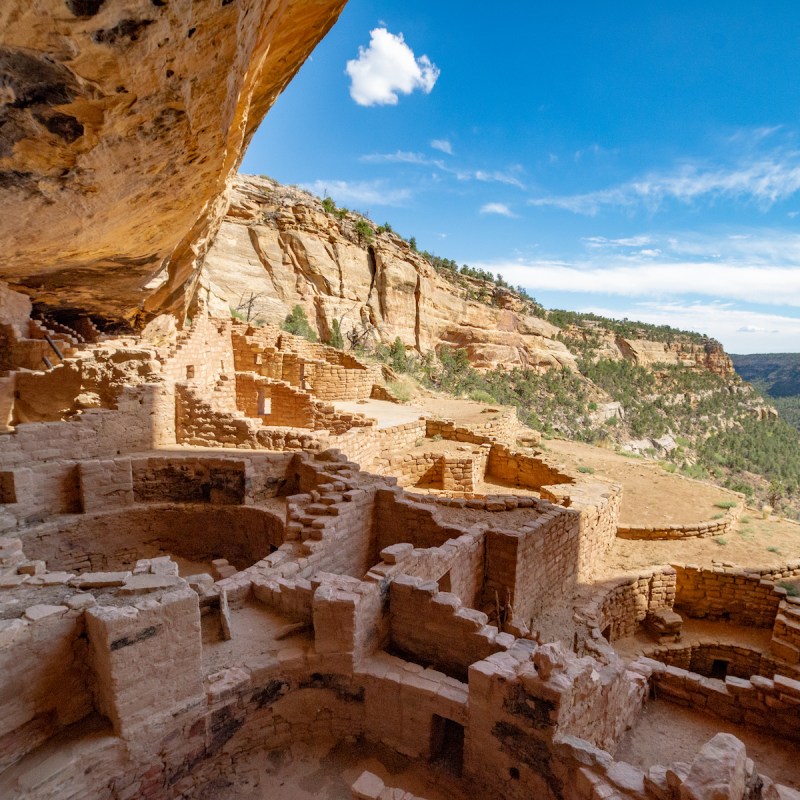
In my field of travel writing, I’ve heard many people dream of seeing historic sites in various parts of the world, especially places that are considered ancient and mysterious. I have been to many of them — the pyramids, Acropolis, Persepolis, Stonehenge, Mayan and Aztec ruins, Terra Cotta warriors and the Great Wall, Japanese gardens, Roman aqua systems and roads, and petroglyphs too numerous to count.
Videos by TravelAwaits
However, there are many legendary places in the United States that are not only worthy of a visit but are just as important to our planet’s history and rival any other ancient place in the world.
As a history buff, I gravitate to ancient sites and visited many places during my lifetime. Here are my favorite ancient places in the U.S., in no particular order.

1. Hopewell Ceremonial Earthworks
Ohio
Built over 2,000 years ago, the Octagon portion of the Hopewell Ceremonial Earthworks is part of a larger network of five hand-built hills spread throughout central and southern Ohio. Steeped in mystery until now, recent studies have revealed the remarkable mounds are tied to the movement of the moon. The Ohio History Connection’s World Heritage Program is applying for the UNESCO designation, joining other World Heritage sites such as the Egyptian Pyramid Fields and Peru’s Machu Picchu.
My trip to this site was in the 1970s while attending the University of Cincinnati. Since then, I have seen numerous ancient mounds in the United States, but the Hopewell site is still the most impressive.

2. Chaco Culture National Historical Park
New Mexico
One of the few UNESCO World Heritage Sites in our nation, Chaco is also one of the least visited. I soon learned why. The dirt road leading to this much acclaimed site was potted with holes that threatened my tires every few feet. More than once I considered turning around and giving up. Once I arrived, all frustrations disappeared at the lovely Pueblo Bonito with its interconnecting rooms that seemed to never end. There are 35 kivas in the complex built in the Four Corners that drew thousands of the first Americans for sharing news, conducting spiritual gatherings, and trading.
Pro Tip: Check the weather before heading out because the rutted dirt roads become very muddy after a rainfall. Shade does not exist here, so bring sunscreen and plenty of water.

3. Mesa Verde
Colorado
Mesa Verde National Park is mainly known for Cliff Palace, ruins built in a large opening on the side of a mountain dating back to 1,300 A.D. However, many other ruins surrounding this site are much older! In total, there are 26 pueblos and different tribes that live in this canyon. The easy trails lead to numerous rock and clay residences built precariously on narrow cave openings hidden behind canyon curves. I extended my stay for a whole day, camping overnight in the very nice campground at the bottom of the mountain.
Pro Tip: The park is occasionally closed in the winter, so check their website for alerts before you go.

4. Aztec Ruins National Monument
New Mexico
This off-the-beaten place was a pleasant surprise. The Aztec Ruins National Monument was not on my list to see, but road signs intrigued my inner “should have been an archeologist” voice and made a detour.
The place is remarkable, and I spent most of an afternoon strolling through building after building, climbing down wooden ladders into kivas, and analyzing every artifact in this expertly designed museum. I lost a day but have never regretted dropping a stop in Durango to see this place well worth a visit.

5. Gila Cliff Dwellings
New Mexico
A new ruin adventure happened last year on a month-long exploration of western New Mexico during a trip to the Gila National Forest. Hidden behind trees in a secluded valley, the Gila Cliff Dwellings had the perfect security situation. This location has also kept thieves and tourist vandalism at bay: The dwellings are as if the inhabitants just left.
Artifacts are safe and sound with the National Park Service, but room layouts, storage place design, and fire smoke marks on the walls tell the story of the people who lived there. I followed a park guide who explained the suggested use of the rooms and what they have learned about the people who lived here.
Pro Tip: The winding switchback road climbing to the mountaintop from Silver City is not for the timid driver. Check the weather before going as the road will be slick when wet; there are few guardrails.

6. Palo Duro Canyon State Park
Texas
Evidence through artifacts prove that humans inhabited the canyon for over 12,000 years, which is displayed in the Palo Duro Canyon State Park’s interpretive center. Stop there first to view a nice video and explore the displays. Foot trails used by various ancient tribes for hunting, gathering plants, and trading among each other are today used as hiking trails.
I camp at this park almost every time I head to the Southwest from my home in East Texas and still have not seen the whole park. Palo Duro Canyon is over 200 miles long and is considered the second largest canyon system in the U.S. next to the Grand Canyon.
Pro Tip: Campgrounds and most trailheads are located at the bottom of the canyon and flood during spring rains. There is a good café in the Trading Post on the canyon floor.

7. Tonto National Monument
Arizona
The Tonto National Monument consists of two Salado cliff dwellings built around 1,300 A.D. The dwellings are not an ancient place themselves, but the history of the native people in the area is. Before the dam and Theodore Roosevelt Lake existed, ancient people relied on the Salt River for survival. Salado is Spanish for “salt.”
The CCC Navajo Mobile Unit projects built in 1940 are also interesting. Located in the Tonto National Forest, the drive on State Route 88 to the dwellings through the 40-mile scenic Apache Trail Canyon is awesome.
Pro Tip: Guided tours of Salado cliff dwellings are available from November–April, are almost 4 hours long, and must be reserved in advance.

8. Petrified Forest National Park
New Mexico
The very first time I visited this park was with my parents as a child. I love the Southwest, so it is no surprise I have been to this park more than once. As a National Park Golden Pass holder, the Petrified Forest is a nice economical stop along a much longer road trip to stretch legs, get a snack, and reminisce about what this area must have looked like so many years ago.
Archeological evidence has discovered six periods of people and cultures dating as far back as 13,500 B.C. — the Paleoindian Period also known as the Ice Age. Paleo Indians were drifters hunting and gathering food, moving from grasslands to forests. Evidence of many hunting tools and arrow tips found proves they stayed longer in the Petrified Forest area. As I walk among trees petrified to a colorful rock, it’s fun to imagine our nation’s ancestors walking the same path when the trees were young saplings.
In later years, ancestral Puebloan people used the petrified trees in the 1300s to make homes, with one still standing, called the Agate House.

9. Newspaper Rock
Utah
Sometimes, the best part of a road trip is discovering a place not on my radar. On my way to the Canyonlands National Park’s southern section one year, a little sign along Highway 211 announced Newspaper Rock. Being a writer, I was intrigued and pulled into the small parking lot.
Newspaper Rock State Historic Site is a lonely gigantic rock where a piece of ancient history unfolds in 650 petroglyphs. Each interesting marking was drawn at a different time during a 2,000-year period and the meaning behind the drawings are still debated today. There are many petroglyphs in Utah, but this rock is the most amazing.
Places I have not seen yet on my future radar of ancient places include the Cahokia Mounds State Historic Site near St. Louis, Missouri — a pre-Columbian settlement of a complex chiefdom society covering 3,953 acres. I also plan to visit the Monumental Earthworks in the Mississippi Valley, created between 3,700 and 3,100 B.C.
For more on archeological sites in the U.S., check out these articles:
